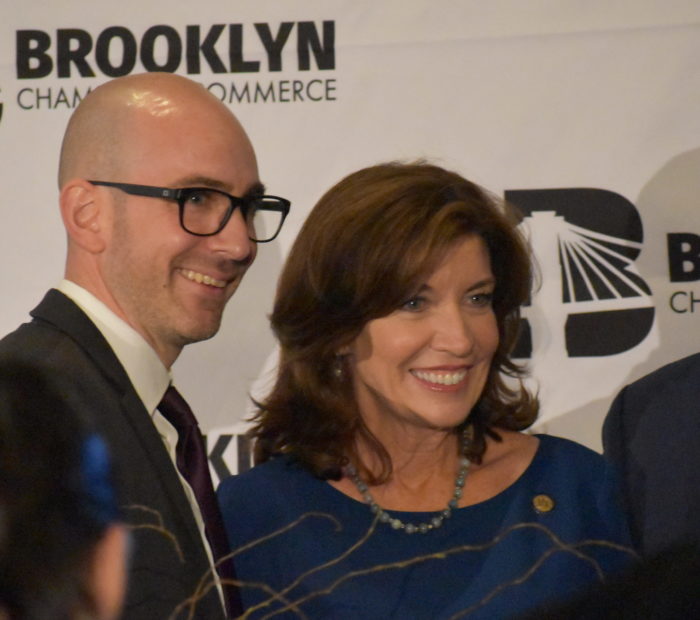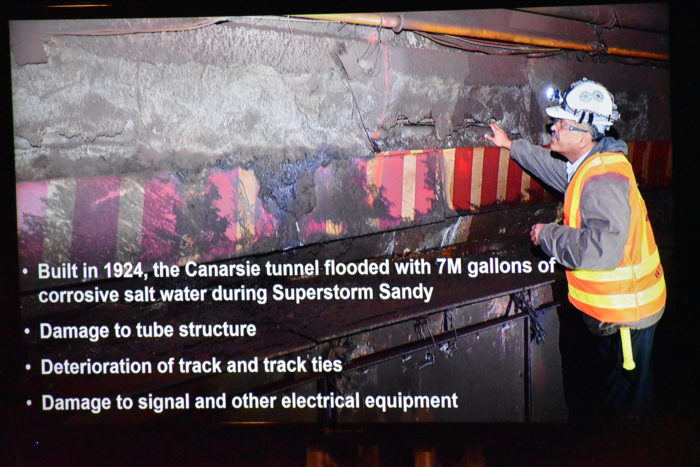Speaking to a crowd of several hundred Brooklynites last night, the chairman of the MTA had to acknowledge the obvious. “As you know, we’ve had some problems with the subway system over the last couple years,” said Joe Lhota. Cue laughter? No, Lhota wasn’t going to give the crowd a chance to chuckle at that understatement. He plunged right into a PowerPoint presentation of his “subway action plan,” which includes a $836 million program to stabilize the broken system. Fixed signals, overhauled cars, new tracks–and 2,700 more transit workers.
“I wake up every morning, sometimes in the middle of the night if someone calls, with the delays we’re having,” he said. “I want to get to a situation where we wake up and there are no delays, and you can get wherever you need to go on the subway system as fast as possible.” Cue applause? At that point, Lhota gave the crowd a moment to offer up a round of affirmation.
The occasion was the annual membership meeting of the Brooklyn Chamber of Commerce, which took place at Gargiulo’s Restaurant in Coney Island. The chamber had much to celebrate, having been named the state’s “chamber of the year” by the Business Council of New York State and looking forward to celebrating its 100th anniversary next year. President and CEO Andrew Hoan announced a plan to create a coalition of community leaders to follow up on its “Brooklyn Prime” campaign to lure Amazon’s proposed second headquarters with a sustained effort to recruit companies to come to Brooklyn, an effort to be partially underwritten by the utility company National Grid.

Chamber CEO Andrew Hoan with New York lieutenant governor Kathy Hochul
Yet the star attraction, given the city’s transit trauma, was Lhota, who Governor Cuomo appointed in June to lead a rescue of the system. This is Lhota’s second stint with the MTA; he was chairman and CEO in 2011-12, before he left to run for mayor. (Lhota hasn’t given up his day job at NYU Langone Health, where he’s senior v.p., vice dean and chief of staff.) Lhota brings a high-powered resume to the complicated transit mess, having served as a top executive at Madison Square Garden and Cablevision, as well as deputy mayor and budget director under Mayor Giuliani.
Lhota, a Brooklyn Heights resident who has lived in the borough for 29 years, started his presentation by reminding listeners that Brooklyn grew up with the transit system, and vice versa. He showed slides of subways crossing the Brooklyn Bridge, in 1907, and of magnificent transit terminals in Downtown Brooklyn and Williamsburg. “Mass transit allowed Brooklyn to become the center of the universe,” he said. “It was the center of manufacturing more so than any other place in the United States, and to me that’s important to remember because that same spirit of Brooklyn has now been revisited again.”
Another spirit he invoked was his “favorite Brooklyn-based transit person,” bus driver Ralph Kramden from The Honeymooners. “Ralph drove the bus down Flatbush Avenue and terminated every single day, the way almost every bus did in Brooklyn, at the Navy Yard, the largest employer in the city of New York at the time, over 70,000 employees every single day.”

One of MTA chairman Lhota’s PowerPoint slides, showing damage to the Canarsie tunnel
Lhota used the Navy Yard’s tech-driven comeback as a hopeful analogy for a transit renaissance. The $836 million action plan is phase one; the longer-term phase two will cost an estimated $8 billion to overhaul a system that carries 6 million subway riders a day, among other transit customers. Among the features he outlined:
Phase one: the plan to bring immediate relief will fix 1,300 signals by the end of next year, expand the number of train cars overhauled every year (from 950 to 1,100), install more reliable track, and launch a pilot program to remove seats from some cars to provide more space for standing customers. Lhota used the example of L-train riders trying to board packed, Manhattan-bound trains in rush hour. They likely won’t get a seat, but at least they’ll have a better chance of getting on board.
Digital transparency: Lhota showed a new “performance dashboard” called MTA Stat, where citizens can monitor the subway’s overall progress. Another advance will be a mobile app, “MTA Subway Time,” due by the end of the year, which will enable riders to get real-time information on subways, buses, and commuter trains.
Improved payment system: The MetroCard, which replaced tokens in 2003, will be retired over several years. In its place will be a new system using contactless payment methods, including mobile apps, bank cards and prepaid debit cards.
New buses and subway cars: New trains, rather than having doors between the cars, will have continuous interiors, allowing for more seats. They’ll have wider doors as well, enabling passengers to get on and off more quickly. (Lhota said he considered some kind of behavior-modification program to dissuade people from standing in the doorways, but realized that it “wasn’t worth the effort.”) More than 2,000 new buses will be on the street by 2020, equipped with free WiFi, USB charging stations, multimedia screens with real-time information, and security cameras.
Renovated stations: As part of the capital-improvement plan, dozens of aging stations will be overhauled and upgraded, including countdown clocks outside the station entrances, enhanced LED lighting, WiFi, and upgraded security systems.
A speedy overhaul of the L-line tunnel: Lhota addressed what he called “the elephant in the room,” the dreaded shutdown of the L train between Williamsburg and Manhattan to fix damage to the Canarsie Tunnel caused by flooding during Hurricane Sandy. The 15-month closure will begin in April 2019. Lhota said the contract for the repairs gives contractors a bonus for early completion and financial penalties for delays. During the closure, the MTA will provide a fleet of alternative transport, including 200 additional buses as well as increased subway and ferry service. Lhota offered the encouraging example of successful Sandy-repair work on other tunnels, notably the Montague tunnel, which was reopened under budget and almost three weeks ahead of schedule.